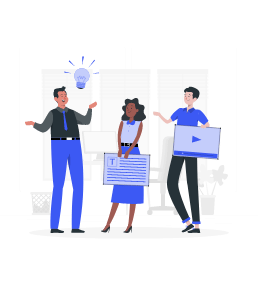Get in touch
By clicking on the button, you agree to the privacy policy
STEP BY STEP
7 Useful Tips for Creating an ERP System Design from Scratch
Estimated reading time: 7 minutes
October 22, 2021
October 22, 2021
STEP BY STEP
7 Useful Tips for Creating an ERP System Design from Scratch
Estimated reading time: 7 minutes
October 22, 2021
October 22, 2021
STEP BY STEP
7 Useful Tips for Creating an ERP System Design from Scratch
Estimated reading time: 7 minutes
October 22, 2021
October 22, 2021
CEO at Aspirity
Written by
Implementing an enterprise resource planning (ERP) system will most likely have many major consequences for your business. If done right, you will be able to manage your enterprise much better, optimize essential processes, and develop improved business strategies.
However, ERP system design and implementation are challenging tasks, and a lot can go wrong during these stages. Especially if you need a heavily customized solution for your business. If you want to design and develop an ERP system, we're here to help you: let's take a look at some of the best tips for ERP system design and implementation.
However, ERP system design and implementation are challenging tasks, and a lot can go wrong during these stages. Especially if you need a heavily customized solution for your business. If you want to design and develop an ERP system, we're here to help you: let's take a look at some of the best tips for ERP system design and implementation.
The Importance of Reliable and Convenient ERP System Design
Business owners are often unaware of ERP systems; they are used for manual processing, including data entry. In other cases, corporations use out-of-box systems, which are challenging to customize, have certain limitations in their ERP system design, and often cannot satisfy all the business needs. Both of these approaches are less than ideal. So, let's take a look at some benefits you can get from designing ERP systems from scratch.
First, you won't have any useless features clattering your system's interface. This allows you to remove any distracting elements and, in addition, prioritize certain features for users from different departments. Obviously, this will reduce the time for performing certain actions and make it easier to introduce new users.
Second, you will be able to fit the system to your needs, and you won't have to change your operations to accommodate the system. Adapting to the system might seem like not a big deal, but there are hidden consequences of such a decision that accumulate in a snowball effect.
Last, a well-built system customized for your operations will have less need for constant maintenance. Furthermore, if you design an ERP system from scratch, you will know all of its details, and it will be easier to maintain it overall.
First, you won't have any useless features clattering your system's interface. This allows you to remove any distracting elements and, in addition, prioritize certain features for users from different departments. Obviously, this will reduce the time for performing certain actions and make it easier to introduce new users.
Second, you will be able to fit the system to your needs, and you won't have to change your operations to accommodate the system. Adapting to the system might seem like not a big deal, but there are hidden consequences of such a decision that accumulate in a snowball effect.
Last, a well-built system customized for your operations will have less need for constant maintenance. Furthermore, if you design an ERP system from scratch, you will know all of its details, and it will be easier to maintain it overall.

ERP System Dashboard by Anton Olashyn for HighSolutions. Source
Steps of ERP System Design Development
Let's review each step of the ERP system design development process using one of our successful projects as an example. The project we'll be reviewing is the project management software for Arctic Business Management company – a Norwegian enterprise specialized in real-estate development and property management.
1. Expectation Definition
The first step in the ERP system design process is to determine your business needs and which features the system needs to satisfy them. This is also the step where you need to determine whether you have the resources to develop the system yourself or need to hire external help.
Referring to us for help, the client has defined their needs and expectations: they needed a system that would contain the information and statistics on tenants, finances, contracts, include to-do lists, calendars, and tasks with dates and deadlines.
Referring to us for help, the client has defined their needs and expectations: they needed a system that would contain the information and statistics on tenants, finances, contracts, include to-do lists, calendars, and tasks with dates and deadlines.
2. Research
The next step of the ERP system design development phase is to conduct a thorough analysis of the requirements, communicate with future system users and management to learn about their operations and working flows in more detail, and find out which proceedings need to be improved the most.
In this particular project, we conducted a thorough investigation of the company to figure out how the end product should look to satisfy them the most. We've thoroughly analyzed all the data provided to us by the client, including the project's feature list.
In this particular project, we conducted a thorough investigation of the company to figure out how the end product should look to satisfy them the most. We've thoroughly analyzed all the data provided to us by the client, including the project's feature list.

Move the slider
3. Functionality Definition and Planning
You can't start designing an enterprise resource planning system without having a defined plan on the features and functional elements that need to be included. The planning should be based on the research conducted and help achieve all the outlined tasks and goals optimally.
In the Arctic project, after we've conducted our investigation, we've compiled the results in terms of reference. It has also helped us create a description of each module in the enterprise resource planning solution, with a clear understanding of how they should work and interact.
In the Arctic project, after we've conducted our investigation, we've compiled the results in terms of reference. It has also helped us create a description of each module in the enterprise resource planning solution, with a clear understanding of how they should work and interact.
4. Defining the User Roles
To ensure the project and data security and simplify the design for each user, certain modules should only be available to users that require them. This is usually done through the next design phase — defining the user roles. They should be determined with the employee's input. The team will then assign roles to each member.
For the Arctic project, besides the main project management software with data available for most of the employees, we've developed a portal for another user role — the board members representing the funds.
For the Arctic project, besides the main project management software with data available for most of the employees, we've developed a portal for another user role — the board members representing the funds.
5. Creating a Prototype and User Testing It
The following design stage is developing an interactive prototype based on the functionality determined earlier. This will help resolve any problems that might occur during the development process. Testing it with the users will allow for determining whether the ERP products meet the established expectations.
In our case, we've used the data obtained and analyzed beforehand to provide a clickable UX prototype to our customers. It has proved our understanding of their needs and expectations. The prototype was approved, and we've moved on to the next stage of the development.
In our case, we've used the data obtained and analyzed beforehand to provide a clickable UX prototype to our customers. It has proved our understanding of their needs and expectations. The prototype was approved, and we've moved on to the next stage of the development.

6. Designing the Interface and Styling
Next is the most technical part of designing a new ERP. It includes determining the visual style for the user interface and creating an intuitive design that would support the workflow and make each feature easy to reach and use.
In our platform design, we've used other products from the client's company, namely their app and website, as an inspiration to figure out the company's unique style. Our designer has also analyzed other real estate-related websites and project management software to create the best design for the project.
In our platform design, we've used other products from the client's company, namely their app and website, as an inspiration to figure out the company's unique style. Our designer has also analyzed other real estate-related websites and project management software to create the best design for the project.

Designing ERP Systems: Update the Existing System or Create from Scratch?
An outdated ERP system is a much less effective tool and can often bring more issues than benefits. However, there are two different approaches to dealing with this problem – either designing a new system from scratch or upgrading the existing one. Which one is better?
In most cases, it comes down to the resources and efforts you would need to spend on either path. Occasionally, an ERP system's vendor might have the system ready for implementation, allowing you to get critical features effectively and fast.
In other cases, the system vendor may only have the systems that better suit other corporate institutions but lack certain features you require. All in all, creating a system from scratch is the solution that will bring your business the most benefits, but it requires spending a lot of time and resources. If you can save more than 25% of the implementation time and costs, it is better to use existing solutions rather than design a new system.
In most cases, it comes down to the resources and efforts you would need to spend on either path. Occasionally, an ERP system's vendor might have the system ready for implementation, allowing you to get critical features effectively and fast.
In other cases, the system vendor may only have the systems that better suit other corporate institutions but lack certain features you require. All in all, creating a system from scratch is the solution that will bring your business the most benefits, but it requires spending a lot of time and resources. If you can save more than 25% of the implementation time and costs, it is better to use existing solutions rather than design a new system.
Read more: User Experience Audit for Your SaaS Product
Have an amazing idea?

We will be happy to develop that idea into an MVP or a full fledge product!
GET IN TOUCH NOW!
Just fill in the form and we'll schedule a meeting
What Makes a Good ERP System Design? 7 Tips
#1 Engage Every Business Department At the Initial Design Stages
To properly define the full functionality of the ERP system, every user should be on the same page in terms of what they want from the platform. If you don't clear up the misunderstandings early on, they might lead to a conflict later on.
Furthermore, if you engage with representatives from different operating departments that will use the ERP system, you might get the insight you would not get otherwise. Conduct brainstorming sessions to determine the best course of action later on.
Furthermore, if you engage with representatives from different operating departments that will use the ERP system, you might get the insight you would not get otherwise. Conduct brainstorming sessions to determine the best course of action later on.

#2 Aim for the Most Effective Collaboration
Usually, complex business operations are all about collaboration. ERP systems must be designed for easy and convenient interactions of an end user with other users and every other part of the service. Include effective and convenient collaboration and communication tools to simplify the operations and eliminate the need for third-party services.
#3 Conduct User Interviews as Much and Often as Possible
To include essential features and accommodate the needs of all the users, you need to communicate closely with them. Conduct interviews during multiple stages of the operation so that you don't miss anything important and every detail is accounted for.
#4 Lean on the Best Practices
In any field, there are certain best practices that get established over time. An experienced design and implementation team will be familiar with these practices, and it would be best to create a design for an ERP system leaning on them. This will spare you the time you'd spend determining the same practices with trial and error.

Enterprise Resource Planning by Zeeshan Khalid. Source
#5 Follow the Less-is-More Principle
Adding helpful functions to your ERP system might seem like a great idea, but having a tool that overflows with features is not that helpful. Non-essential features clutter the interface and make the system harder to operate. So, resort to including the most effective tools and lay them out in a simple and coherent manner.
#6 Make the Design as Intuitive as Possible
Your ERP system should be easily accessible and understandable to all the people that will use it. The easier the system is to adopt, the better it is for the business, and the sooner it will be able to fully benefit from it. An intuitive dashboard is one of the great examples of features that support this design principle.
#7 Consider Adapting to Mobile Devices
Having a mobile-compatible design is a current trend for many types of software solutions, and EPR systems is one of them. The mobile accessibility will help make your system available anywhere at any time, thus making it easier for employees to operate, and open a possibility of remote work.
Consider Aspirity Your Trusted Partner
Aspirity has a lot of experience developing reliable solutions with a flexible architecture, intuitive and well-thought-out UI/UX design. Besides the Arctic Business Management project we've already mentioned, our team has worked on various other platforms, including the equipment management software for a design-engineering bureau.
If you need any help with creating a solution for your business, we're ready to assist!
If you need any help with creating a solution for your business, we're ready to assist!

Final Thoughts
Now that you know more about how to design an ERP system, you can make the right decisions for your ERP system development. Use our tips to create the platform fit for all your needs, or, if you don't have the expertise or resources for it, contact Aspirity to get professional help.
This article was written in collaboration with Maria D. — UI/UX Designer at Aspirity
CEO at ASPIRITY
For more than 2,5 years, I've been working as CEO at Aspirity. I help professionals launch digital products by providing dedicated development teams.
Written by
Want to know more?
Read our other articles
Competitive peer-to-peer marketplace software development guide. The description and benefits of this model, stages, and requirements for its creation.
Considering building scalable React apps but still not sure if it's a good idea? Here's the list of the main benefits of using React for any sized project.
Is your web site providing the best front-end performance? Or are you not using any of the popular techniques to make it load faster?
Is insurance digital transformation and digitization relevant for your industry? Read on to see how to minimize the main challenges of digitizing in the insurance industry.
How to choose telecom expense management software? What are the benefits of a TEM system, and how to implement it most efficiently?
Eager to obtain a custom design for a real estate website? Check out the best practices and get blown away by the examples of innovative websites.

Building custom software or have an existing one?
Aspirity is an offshore web development agency. We specialize in management, admin, and dashboard software.
If you have a custom software project — contact us for a confidential consultation or just read more from our blog.
If the article seemed interesting to you, share it with your friends
Aspirity is an offshore web development agency. We specialize in management, admin, and dashboard software.
If you have a custom software project — contact us for a confidential consultation or just read more from our blog.
If the article seemed interesting to you, share it with your friends





